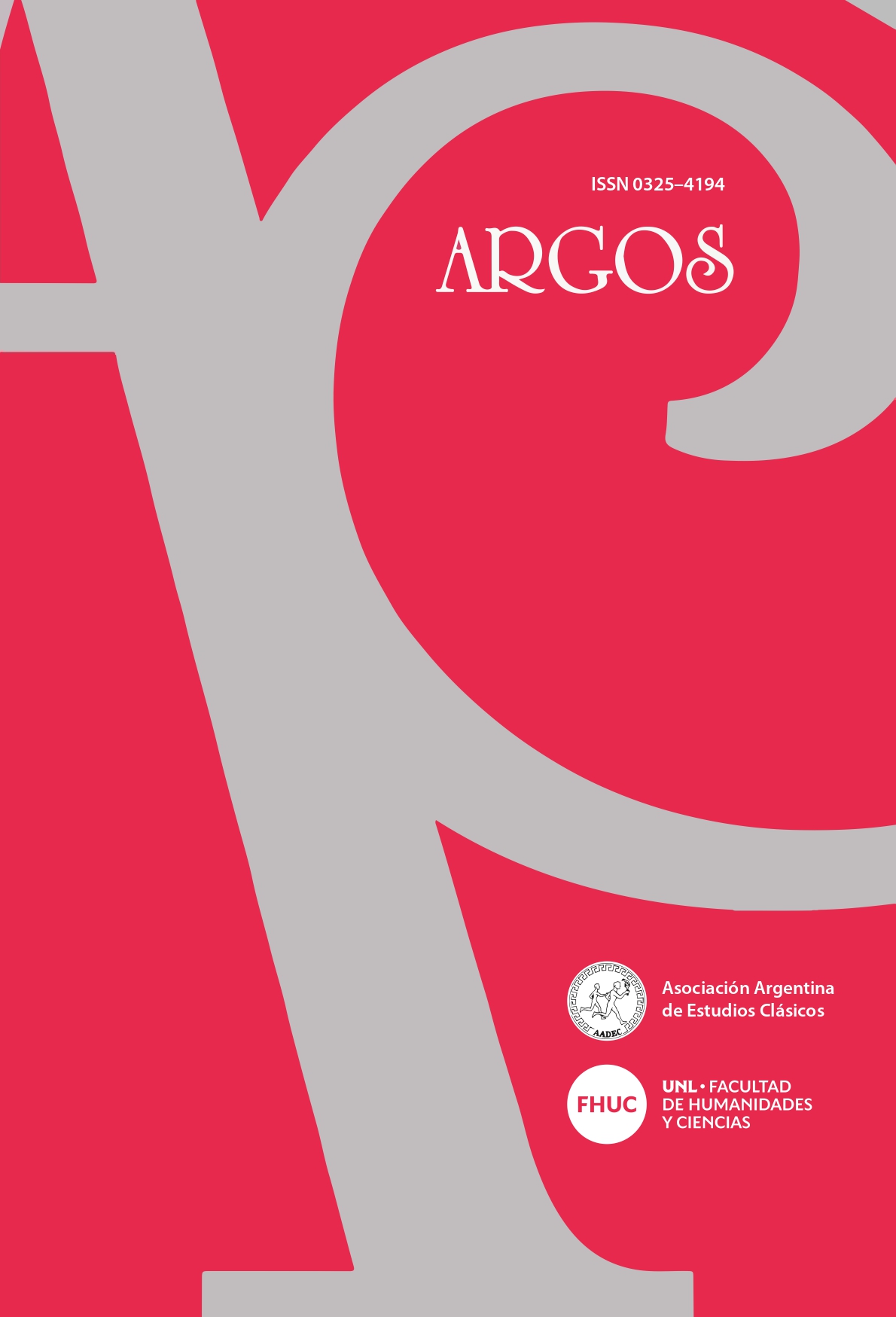Sileno en la Égloga 6 de Virgilio: una captura en clave bucólica
DOI:
https://doi.org/10.14409/argos.2023.50.e0058Keywords:
Narration, Silenus, Eclogues, Virgil, Classical AntiquityAbstract
In Virgil”s Eclogue 6 (vv. 13-30) there is a scene in which two young men, Chromis and Mnasyllos, surprise the old satyr Silenus sleeping in a cave and, pretending a sort of a capture, they “compel” him to fulfill the promise to sing a song for them. Silenus is a mythological character with a long tradition, widely documented already from the 5th century B.C and characterized by his wisdom. The story of his capture by the order of King Midas, who wanted him to reveal his knowledge, is present in many different authors (e.g. Herodotus, Theopompus, Xenophon). Our article will examinate the construction of the character proposed by the Virgilian”s tale, which reiterates certain features from tradition but, at the same time, incorporates new elements. We will try to distinguish the meaning of those narrative components by which Virgil reappropriates of this figure in a bucolic key.
References
Bibliografía
ALBRECHT, M. Von (2013). Virgilio: Bucólicas, Geórgicas, Eneida, Murcia.
ÁLVAREZ HERNÁNDEZ, A. (2014). “Deductum carmen - deducere ornos: Acerca del programa bucólico virgiliano en la Égloga 6”, REC nº 41, pp. 13 – 35.
----------------------------- (2018) “Alusiones a Calímaco en Verg. Ecl. 1, 1-5”, XXV Simposio Nacional de Estudios Clásicos, Buenos Aires.
BAILEY, C. (1962). Lucreti. De rerum natura, Oxford.
BREED, B. W. (2000). “Silenus and the imago vocis in Eclogue 6”, HSCPh, Vol. 100, pp. 327-339.
CLAUSEN, W. (1994). Virgil Eclogues. With an introduction and commentary by Wendell Clausen, Oxford.
COLEMAN, R. (1997). Vergil. Eclogues. En Greek and Latin Classics, Cambridge.
CUCCHIARELLI, A. (ed.) (2012) Publio Virgilio Marone. Le Bucoliche. Introduzione e commento di A. C. Traduzione de A. Traina, Roma.
DFHG- Digital Fragmenta Historicorum Graecorum, Leipzig.
DI VIRGINIO (1962). Cicerone. Le Tusculanae. Trad. H. Drexler, Milán.
ELDER, J. P. (1960). “Non iniussa cano. Virgil”s Sixth Eclogue”, HSPh 65, pp. 109-125.
GLARE, P. G. W. (1982). Oxford Latin Dictionary, Oxford
GODLEY, A. D. (1920). Herodotus. The Histories, Cambridge. Disponible en Proyecto Perseus, https://www.perseus.tufts.edu/.
GORDON WASSON, R., Hofmann, A., Ruck, C. (2008) The Road to Eleusis: Unveiling the Secret of the Mysteries, Berkeley.
Gow, A. S. F. (ed.) (1950). Theocritus. Vol. 1: Introduction, Text and Translation. Vol. 2: Commentary, Appendix, Indexes and Plates, Cambridge
HUBBARD, M. (1975). “The capture of Silenus”, PCPhS, vol. 21, pp. 53-62.
INGBERG, P. (2004). Virgilio. Bucólicas, Buenos Aires.
LEWIS, C. T., Short, C. (1969) A Latin dictionary, founded on Andrews” edition of Freund”s Latin Dictionary, Oxford.
MARCHANT, E. C. (1961). Xenophontis opera omnia, vol. 3, Oxford. Disponible en Proyecto Perseus, https://www.perseus.tufts.edu/.
OTTAVIANO, S. y CONTE, G. (ed.) (2013). P. Vergilivs Maro. Bucolica. Georgica, Berlín.
Recio García, T. de la Ascensión y Soler Ruiz, A. (1990) Virgilio. Bucólicas. Geórgicas. Apéndice Virgiliano, Madrid.
RODRÍGUEZ-NORIEGA GUILLEN, L. (tr.) (1998). Ateneo. Banquete de los eruditos. Libro I-II, Madrid.
Segal, C. (1971). “Two Fauns and a Naiad? (Virgil, Ecl. 6, 13-26)”, AJPh, vol. 92, no. 1, 1971, pp. 56–61.
STEWART, Z. (1959). “The song of Silenus”, HSCPh 64, pp. 179-205.
THILO, G., Hagen, H. (1881-1887). Servii grammatici qui feruntur in Vergilii carmina comentari, Cambridge.
ThlL, Thesaurus Linguae Latinae (1900–). Leipzig. Disponible en https://thesaurus.badw.de/en/project.html
Downloads
Published
How to Cite
Issue
Section
License
Copyright (c) 2024 Argos

This work is licensed under a Creative Commons Attribution-NonCommercial-ShareAlike 4.0 International License.



